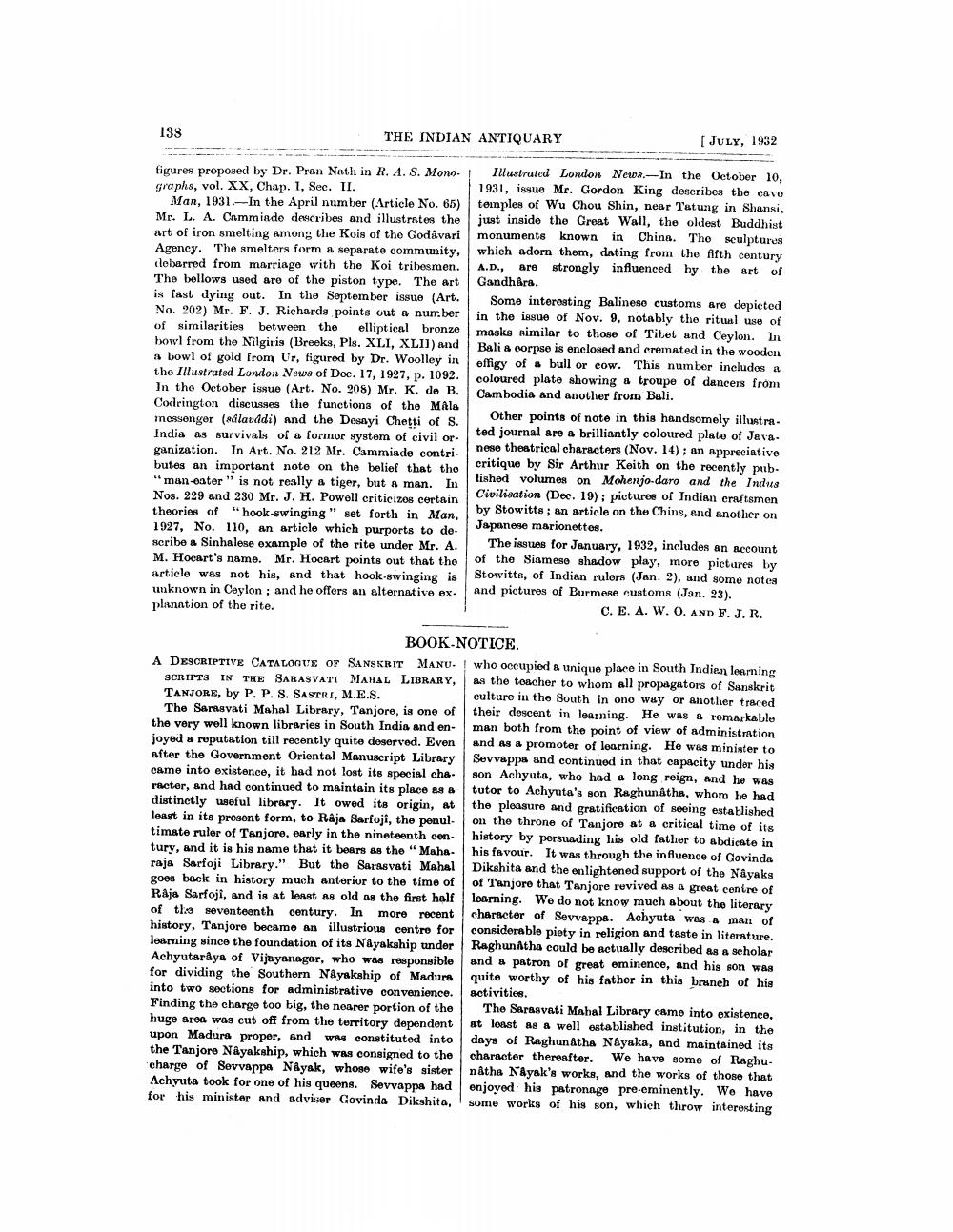________________
138
THE INDIAN ANTIQUARY
[JULY, 1932
figures proposed by Dr. Pran Nath in R. A. S. Mono! Illustrated London News.-In the October 10, graphs, vol. XX, Chap. 1, Sec. II.
1931, issue Mr. Gordon King describes the cavo Man, 1931.-In the April number (Article No. 65) temples of Wu Chou Shin, near Tatung in Shansi, Mr. L. A. Cammiade describes and illustrates the just inside the Great Wall, the oldest Buddhist art of iron smelting among the Kois of the Godavari monuments known in China. The sculptures Agency. The smelters form a separate community, which adorn thom, dating from the fifth century clebarred from marriage with the Koi tribesmen. A.D., are strongly influenced by the art of The bellows used are of the piston type. The art Gandhára. is fast dying out. In the Soptember issue (Art. Some interesting Balinese customs are depicted No. 202) Mr. F. J. Richards points out a nunc.ber in the issue of Nov. 9, notably the ritual use of of similarities between the elliptical bronze masks similar to those of Tibet and Ceylon. In bowl from the Nilgiris (Breeks, Pls. XLI, XLI]) and Bali & corpse is enclosed and cremated in the wooden a bowl of gold from Ur, figured by Dr. Woolley in effigy of a bull or cow. This number includos a tho Illustrated London News of Dec. 17, 1927, p. 1092.
coloured plate showing a troupe of dancers from In tho October issue (Art. No. 205) Mr. K. de B. Cambodia and another from Bali. Codrington discusses the functions of the Mala
Other points of note in this handsomely illustra. messenger (adlavddi) and the Desnyi Chetti of S. India as survivals of a formor system of civil or.
ted journal are a brilliantly coloured plato of Jevaganization. In Art. No. 212 Mr. Cammiade contri.
nese theatrical characters (Nov. 14); an appreciativo
critique by Sir Arthur Keith on the recently pub. butes an important noto on the belief that tho
lished volumes on Mohenjo-daro and the Indus "man-eater" is not really a tiger, but a man. In Nos. 229 and 230 Mr. J. H. Powell criticizos certain
Civilisation (Dec. 19): pictures of Indian craftsmen theories of "hook-swinging " set forth in Man,
by Stowitts; an article on the Chins, and another on 1927, No. 110, an article which purports to de
Japanese marionettes. scribe & Sinhalese example of the rite under Mr. A.
The issues for January, 1932, includes an account M. Hocart's name. Mr. Hocart points out that the of the Siamese shadow play, more pictures by article was not his, and that hook-swinging is Stowitts, of Indian rulers (Jan. 2), and some notes unknown in Ceylon; and he offers an alternative ex and pictures of Burmese customs (Jan. 23). planation of the rite.
C. E. A. W. O. AND F. J. R.
BOOK-NOTICE. A DESCRIPTIVE CATALOQUE OF SANSKRIT MANU. who occupied a unique place in South Indien learning
SCRIPTS IN THE SARASVATI MAHAL LIBRARY, as the teacher to whom all propagators of Sanskrit TANJORE, by P. P. S. SASTRI, M.E.S.
culture in the South in ono way or another traced The Sarasvati Mahal Library, Tanjore, is one of their descent in learning. He was a romarkable the very well known libraries in South India and en- man both from the point of view of administration joyed a reputation till recently quite deserved. Even and as a promoter of learning. He was minister to after the Government Oriental Manuscript Library Sevvappa and continued in that capacity under his came into existence, it had not lost its special cha. son Achyuta, who had a long reign, and he was racter, and had continued to maintain its place 88 tutor to Achyuta's son Raghunatha, whom he had distinctly useful library. It owed its origin, at the pleasure and gratification of seeing established least in its present form, to Raja Sarfoji, the penul. on the throne of Tanjore at a critical time of its timate ruler of Tanjore, early in the nineteenth con history by persuading his old father to abdicato in tury, and it is his name that it bears as the "Maha his favour. It was through the influence of Govinda raja Sarfoji Library." But the Sarasvati Mahal Dikshita and the enlightened support of the Nayaks goes back in history much anterior to the time of of Tanjore that Tanjore revived as a great centre of Raja Sarfoji, and is at least as old as the first half learning. Wo do not know much about the literary of the seventeenth century. In more recent character of Sevvapps. Achyuta was a man of history, Tanjore became an illustrious centre for considerable piety in religion and taste in literature. learning since the foundation of its Nayakship under Raghunatha could be actually described as & scholar Achyutaraya of Vijayanagar, who was responsible and a patron of great eminence, and his son was for dividing the Southern Nåyakship of Madurs quite worthy of his father in this branch of his into two sections for administrative convenience. activities. Finding the charge too big, the nearer portion of the The Sarasvati Mahal Library came into existence, huge area was cut off from the territory dependent at last as a well established institution, in the upon Madura proper, and was constituted into days of Raghunatha Nayaka, and maintained its the Tanjore Nayakahip, which was consigned to the character thereafter. We have some of Raghucharge of Sevvappa NÅyak, whose wife's sister nåtha Nayak's works, and the works of those that Achyuta took for one of his queens. Sevvappa had enjoyed his patronage pre-eminently. We have for his minister and adviser Govinda Dikshita, some works of his son, which throw interesting




